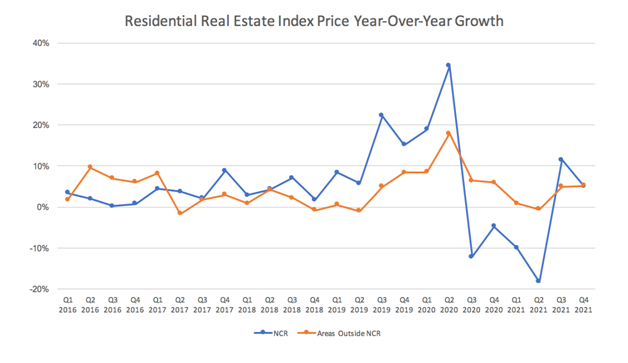MONDAY MACRO: Demand for residential properties fell sharply during the pandemic lockdowns, but this indicator is signaling a recovery

Real estate was undeniably one of the hardest-hit industries during the pandemic. Employees cleared out offices to work from home, retail spaces saw little to no foot traffic due to the lockdowns, and residential properties took a backseat in the Filipinos’ planned investments.
Today, we focus specifically on residential properties and turn to this indicator to see what trends emerged during the pandemic, as well as gauge the overall growth of the residential property market during that period and the subsequent periods.
Philippine Markets Newsletter:
The Monday Macro Report
Powered by Valens Research
A direct investment in real estate—as opposed to Real Estate Investment Trusts (REITS)—requires a more significant capital outlay. However, there are several factors that make real estate, particularly residential properties, worth the investment.
Residential real estate provides a permanent residence for the homeowner, and is a hedge against inflation as property values tend to rise over time. Additional properties can also be converted into rental spaces that provide the owner with extra income.
Millennials are the prime drivers of demand for residential properties. Some of them are starting families, but most are just looking to purchase their own independent living spaces, especially considering the switch to work-from-home setups.
Working remotely, furthermore, is providing millennials and other homebuyers the opportunity to move away from the big cities and into developing, less population-dense areas where properties are relatively more affordable.
To confirm these trends as well as other general residential real estate trends, we return to the Residential Real Estate Price Index (RREPI).
The RREPI measures the average price change of various residential properties within the country over a time period. Higher movements in the index generally signal higher demand and vice-versa, with a host of other factors such as nearby developments, inflation rates, and interest rates playing into the demand level.
In Q2 2020, the year-over-year RREPI for properties in the National Capital Region (NCR) increased to 34.3% from 18.9% in the previous quarter. All residential properties outside of NCR also saw an uptick in price, rising to 17.8% from 8.5% over the same period.
In the four quarters following, the RREPI for NCR properties saw a consistent negative growth. Meanwhile, the RREPI for properties outside NCR, although declining, still saw positive growth before inflecting to negative levels in Q2 2021.
It seems that because of work-from-home arrangements, traveling or living in NCR for work has been largely optional, especially for those whose permanent residences are in the province. These people likely went back, while some choose to move out of the metro and into more affordable, up-and-coming areas.
Since then, the government has loosened pandemic restrictions, with some companies bringing part of their workforce back into offices. But broadly, with the economy in recovery, demand for residential properties is once again on an upswing.
The RREPI for NCR properties jumped from negative levels to 11.4% in Q3 2021, but has since cooled to 5% in the quarter following. Meanwhile, properties outside NCR saw consistent price growth of about 5% through Q4 2021.
The recovery in the residential real estate sector is likely to continue its upward trajectory going forward supported by an optimistic macro environment. Chiefly, higher expected GDP and an increase in OFW remittances should provide a healthy boost in the sector.
Furthermore, growth in infrastructure by the government and private institutions would likely drive demand in residential areas near these developments.
In particular, it is interesting to note that properties outside of NCR are seeing more growth as prospective homeowners look into less crowded, more affordable areas. Planned projects such as airports, highways and railways connecting to the metro, malls, and other infrastructure are major drivers of the growth in ex-NCR properties.
Overall, the Philippine residential real estate sector has a bright future ahead, especially for developing areas outside NCR.
Investors who are planning to invest directly in this market, or already have investments in these assets, would find it useful to monitor the RREPI to see how growth in this space will continue. Specifically on whether demand would flow back to NCR as businesses bring their employees back to their offices.
About the Philippine Markets Newsletter
“The Monday Macro Report”
When just about anyone can post just about anything online, it gets increasingly difficult for an individual investor to sift through the plethora of information available.
Investors need a tool that will help them cut through any biased or misleading information and dive straight into reliable and useful data.
Every Monday, we publish an interesting chart on the Philippine economy and stock market. We highlight data that investors would normally look at, but through the lens of Uniform Accounting, a powerful tool that gets investors closer to understanding the economic reality of firms.
Understanding what kind of market we are in, what leading indicators we should be looking at, and what market expectations are, will make investing a less monumental task than finding a needle in a haystack.
Hope you’ve found this week’s macro chart interesting and insightful.
Stay tuned for next week’s Monday Macro report!
Regards,
Angelica Lim
Research Director
Philippine Markets Newsletter
Powered by Valens Research
www.valens-research.com





